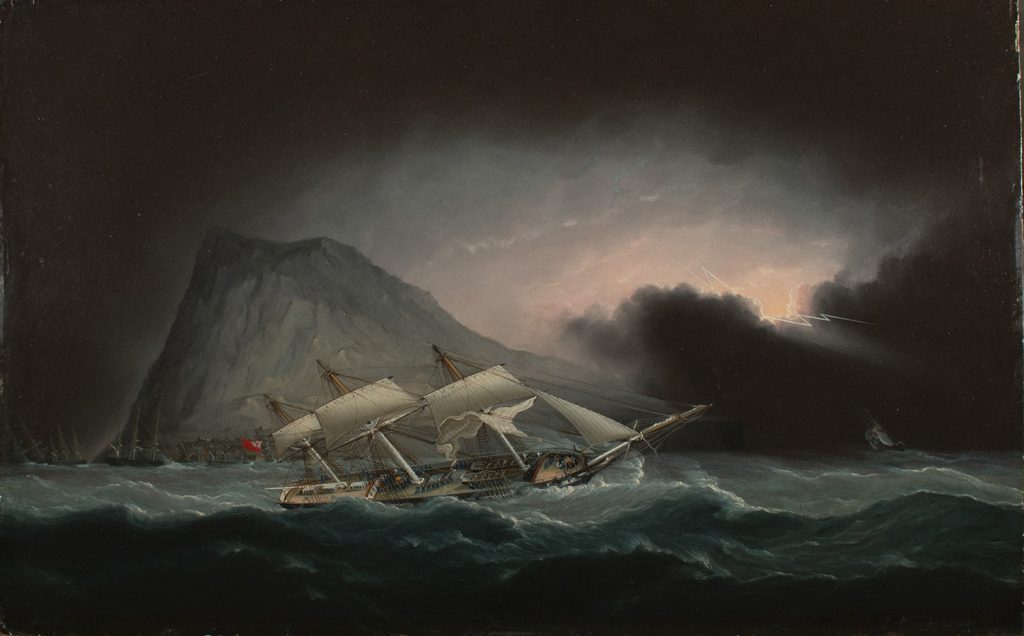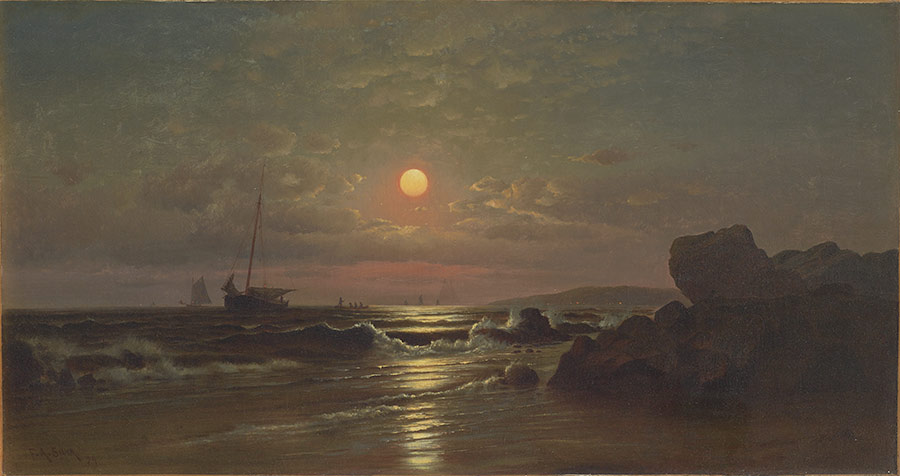This week I have been considering Black Squall at Gibraltar, a recent addition to the collection. Its maker, James E. Buttersworth, is one of those artists, like Arthur Fitzwilliam Tait, who was prolific and comfortably successful in his own time, but who has mostly escaped scholarly attention in the years since his death. Like Tait, Buttersworth worked largely on a smaller scale, selling his paintings for relatively modest prices—one estimate is that most of his works were sold for between twenty and fifty dollars—to a wide variety of customers.1 Born in England, where he was trained by his father (also a marine painter), Buttersworth arrived in the United States by 1847, just in time to capture a number of changes in the American maritime industry. The 1850s saw the peak of the clipper ship, a kind of swept-back, fast-moving sailing ship designed to prioritize speed over carrying capacity. Built originally for the tea trade with China, these ships became essential to the speedy transmission of supplies to San Francisco during the California Gold Rush. The clippers were the subject of constant fascination from the public, which clamored for prints depicting the newest holders of various transit records, in particular of the route from New York to San Francisco around the Cape of Good Hope. The clippers were in many ways the height of the Age of Sail, but they were also the beginning of its decline, as wooden-hulled sailing ships would soon be overtaken by coal-powered steamships. Finally, American yachts were also beginning to make an impact on the sport of sailing, and famous winners were another subject of media fascination. Buttersworth specialized in representing all three, with his ability to accurately depict rigging and other details of shipboard architecture particularly prized by collectors.2

Black Squall at Gibraltar is a tour-de-force of marine painting, perfectly blending Buttersworth’s ability to accurately represent ships with his perfectly timed sense of the drama inherent to life on the sea. As I looked at it, I couldn’t help but think of another painting in the collection, Francis A. Silva’s Moonrise on the New England Coast. Silva’s seascape shares many elements in common with Buttersworth’s, including the depiction of a rocky shore, ships and boats, and an expert handling of the effects of light on the open water. A few weeks ago, I wrote about another seascape, by the American painter William Trost Richards. In that post, I related the growing American preference for the genre starting around 1870. Silva’s painting stands resolutely in that tradition, with scholars remarking on the way that it seems to build upon the seascape tradition established by John F. Kensett and Sanford R. Gifford, among others.3 Dating from a period later in his career when he increasingly turned to nocturnes and sunset scenes, Moonrise on the New England Coast sets a scene of calm serenity. It is however punctuated by uncertainty, as Silva may have represented the aftermath of a shipwreck: a small boat full of figures is seen fleeing the ruin of their larger vessel.4

Eagle-eyed readers will have noted that I have called Silva’s work a seascape, while I have used the term marine painting to describe Black Squall at Gibraltar. Though they might seem like synonyms, the literature on such paintings is careful to distinguish between the two. In the words of Stuart M. Frank, a foremost expert on the genre,
“What distinguishes marine painting from seascape and other genres as a special class of fine arts is the indispensable value of technical proficiency. Marine pictures are judged on the dual standard of aesthetics and technical accuracy, where technical accuracy is a prerequisite.”5
It is just that eye for detail
that distinguishes the two paintings. Silva’s calm, somewhat eerie seascape is ultimately
concerned with capturing and evoking a mood, not with the details of the boats
that populate its outer reaches. Buttersworth, for all the drama of his
depiction of this unnamed clipper ship’s encounter with a storm at the mouth of
the Mediterranean, has always at the forefront of his mind the importance of
technical mastery, which was highly valued by his discerning and knowledgeable
patrons. Though we do not know the name of this particular ship, it is quite
likely that a contemporary observer might have known her from just these
details, in particular the careful way that Buttersworth has represented her
rigging as the crew scrambles to furl the sails before they are torn to shreds
by the onrushing tempest. In fact, he was well known for his ability to capture
sails and rigging under just such difficult conditions.6 Perhaps
future research (Buttersworth’s archives remain unlocated) will enable us to
name this ship. Until then, I will remain impressed at Buttersworth’s
impeccable rendering of this moment of maximum drama.
1 Alan Granby and Janice Hyland, Flying the Colors: The Unseen Treasures of Nineteenth-Century American Marine Art (New York: Hudson Hills Press, 2009), 160.
2 Rudolph J. Schaefer et al., J. E. Buttersworth: 19th-Century Marine Painter, Second ed., rev.expanded (Mystic, Conn: Mystic Seaport, 2009), 25.
3 Francis A Silva et al., Francis A. Silva (1835-1886): In His Own Light (New York, N.Y.: Berry-Hill Galleries, 2002), 12–15.
4 Silva et al., 44–46. The predominance of sunset scenes in Silva’s oeuvre at this point might in fact argue that Moonrise on the New England Coast is a sunset scene, though the painting has long been known by its current title.
5 Stuart M. Frank, “Saltwater Glory: Visions of American Seafaring Prowess in the Age of Sail,” in Flying the Colors: The Unseen Treasures of Nineteenth-Century American Marine Art, ed. Alan Granby and Janice Hyland (New York: Hudson Hills Press, 2009), xv.
6 Schaefer et al., J. E. Buttersworth, 27.



